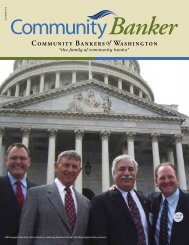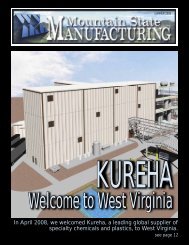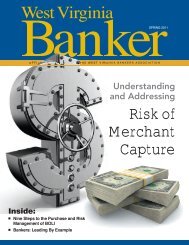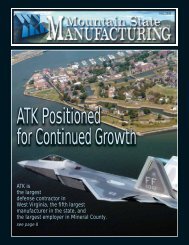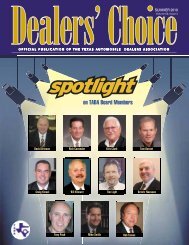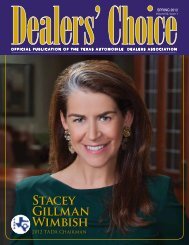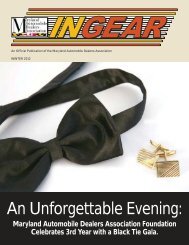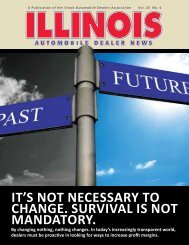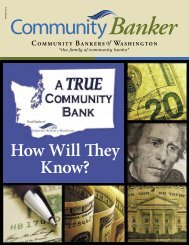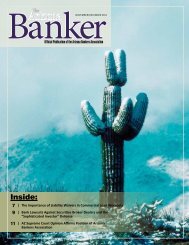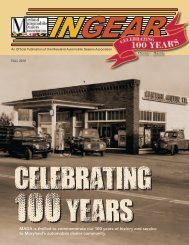Inside: - Media Communication Group
Inside: - Media Communication Group
Inside: - Media Communication Group
You also want an ePaper? Increase the reach of your titles
YUMPU automatically turns print PDFs into web optimized ePapers that Google loves.
SPRING 2013You’re Invited!The AzBA 110thAnnual Convenon<strong>Inside</strong>:8 | 2013 Banker Day at the Capitol12 | “I’m Not Just a Banker Anymore”20 | Cyber Crime and Cyber Liability - Is Your Bank Protected?
See 529college savings plansin a new light.Join the Arizona banks offering a tax-advantaged529 college savings plan. As program managerof the AFCSP (Arizona Family College SavingsProgram), College Savings Bank has the productsand experience to help strengthen and secureyour clients’ portfolios. Benefits include:• Tax-advantaged CD options• FDIC insured up to $250,000 for accountsheld in the same right and capacity• State deduction for Arizona taxpayers($750 single; $1,500 married, filing jointly)Participating banks receive commission (from0.15% to 2.4%) on clients’ contributions, as wellas free supplies of all marketing and enrollmentmaterials.Become part of Arizona’s state-sponsored 529 plan with College Savings Bank’s AFCSP.Contact Jason Lampa • 800.888.2723 • jason.lampa@collegesavings.com • arizona.collegesavings.com©2012 College Savings Bank Member FDIC. All Rights Reserved. College Savings Bank is the program manager for the Arizona State 529Program. The Bank also offers various deposit products under traditional IRA, Roth IRA and non-tax advantaged programs. Before investing inany of the plans offered by College Savings Bank, advisors should ensure that these products meet the suitability requirements of your clientand that all financial, tax and legal requirements have been considered. Early withdrawal penalties apply, and non-qualified withdrawals aretaxable. Read plan disclosure statements carefully before you invest or send any money. The Arizona Family College Savings Program is notinsured by the State of Arizona. Neither the principal invested nor the investment return is guaranteed.
FINANCIALINSTITUTIONSOur financial services lawyers representfinancial institutions of all sizes rangingfrom institutions with $340 billion in assetsto local community banks with $30 millionin assets. The breadth of our practiceensures that we have handled virtuallyevery issue an Arizona financial institutionmight have, enabling you to getsophisticated, efficient and focusedsolutions to your financial services issues.John M. WelchPhoenix Office Managing Partnerjohn.welch@squiresanders.com+1 602 528 494039 Offices in 19 Countriessquiresanders.com
A MESSAGE FROM THE PRESIDENTBY PAUL HICKMAN, PRESIDENT & CEOContinuing a Fast Tempoof ActivityAS I SAT DOWN TO WRITE THIS COLUMN ONWHAT’S GOING ON AT THE ASSOCIATION, ITOCCURRED TO ME THAT THE ECONOMICAND POLITICAL CONTEXT IN WHICH OURmembers operate require some acknowledgment.Indeed, in order for the Association to moreeffectively help facilitate the success of our members,all of our programs and initiatives must beundertaken with a recognition of those issues.It is therefore significant to note that whilesome of the broader economic indicators areimproving, the political paralysis in Washingtonis still preventing the private business sectorfrom growing the economy to its full potential.Annual GDP is rising,albeit not as quicklyor to the climbs theeconomy is capableof achieving. Unemploymentis declining,although not as quicklyas we would like —nor to the depths theFed has indicated arenecessary to adjustinterest rates. And, the ascension in the stockmarket seems impervious to any of the newscoming out of Washington.We will connue to have workshopsand provide best-in-class educaonalofferings for you and your directors thatmake navigang the difficult economicand polical landscape in which we aredoing business a lile easier.A recent study by the Federal Reserve Bankof St. Louis, however, points out that publiclylisted companies held $4.75 trillion in cash in2012. That is up from just $1.2 trillion in 1995. Sowhat’s going on here? One interpretation is thatpile of cash in our banks is a manifestation of theuncertainty in corporate America preventing theinvestment in plant, capital, and human resourcesthat would jump start our economy.The business class is waiting for some intelligiblesigns from Washington that our politicalleaders are ready to get serious about the runawayentitlement spending that is devouring anever greater share of the national budget pie. Thesequester that we are experiencing is governmentbudgeting on auto-pilot heading towarda bottom line figure that refuses to disturb ourunsustainable spending levels on Medicare,Medicaid, and Social Security. At some pointthis has to beg the question of when our entirefederal government becomes one giant healthinsurance company.Here at home we are, as usual, tracking thenational economy within a point or two onunemployment and growth. Housing, whichhas been an unnaturally large component of oureconomy, is beginning to show renewed signs oflife. Home price increases in Arizona continueto lead the nation. We at the Arizona BankersAssociation remain hopeful that our state politicalleaders will continue to work to diversify ourstate’s economy into more high-tech/high-wagevocations. A thriving housing market needs afoundation of a solid and economically diversehome buying public. That requires industriesother than home building.The bankers association, meanwhile, continuesa fast tempo of activity. We brought a newDirector of Member Services onto our small staffat the beginning of the year, Theresa Kleinlein.We had a very successful Banker Day at theCapitol in February. (See 2013 Banker Day at theCapitol, page 8). Also in February we took fourbankers to Washington, D.C. to meet with freshmenmembers of our congressional delegation.(See Why Go To Washington D.C.?, page 6). Wehave several more trips planned for this year: onein April and one in October. If you are interestedin making a difference in policy for our industry President’s Message | continued on page 114 www.azbankers.org
A legal partner you can trust.Jeff Ekbom Partner602.212.8524jekbom@stinson.com1850 N. Central Avenue, Suite 2100Phoenix, AZ 85004PhoenixKansas CitySt. LouisDenverWashington, D.C.OmahaWichitaOverland ParkJefferson CityDecaturA valued partner is one who understands thenuances of your business and the importance ofrelationships secured by trust. Stinson’s bankingattorneys are focused, yet creative. Thoughtful, yettenacious. These qualities can be instrumental inhow we help clients find solutions to even the mostcomplicated deals and deliver optimal results.Innovative ideas. Straightforward solutions.Stinson.comThe choice of a lawyer is important and should not be based solely on advertisements.
111 West Monroe, Suite 440Phoenix, Arizona 85003Phone: (602) 258-1200 • Fax: (602) 258-8980AzBA BOARD OF DIRECTORS2012-2013Lynne Herndon, ChairmanCity PresidentBBVA Compass BankMike Thorell, Chairman-ElectPresidentPinnacle BankBenito Almanza, Vice-ChairArizona PresidentBank of AmericaJames Lundy, Immediate PastChairmanCEOAlliance Bank of ArizonaToby DayArizona PresidentArizona Business BankGail GracePresident & CEOSunrise Bank of ArizonaStephen JohnsonPresident, ArizonaM&I BankChuck LuhtalaPresidentCanyon Community BankBrian RileyPresident & CEOMohave State BankJoseph StewartChairman & CEO, ArizonaJPMorgan Chase Bank, N.A.Gerrit Van HuisstedeRegional PresidentWells Fargo BankCandace WiestPresident & CEOWest Valley Naonal BankAzBA STAFFPaul HickmanPresident & CEOJan ArredondoDirector, AdministraonTheresa KleinleinDirector, Markeng and Member ServicesWhy Go ToWashington D.C.?THIS INDUSTRY IS LARGELY REGULATED OUT OF WASHINGTON D.C.; FROM DODDFRANK TO BASEL III TO CREDIT UNION BUSINESS LENDING TO MORTGAGE LENDING. STATE BANKERS ASSOCIATIONS MAKE IT A PRACTICE OF TAKING BANKERSAND BANK DIRECTORS TO D.C. ON A REGULAR BASIS. THE TRIPS ARE FOCUSED ONmembers of the AZ congressional delegation and senior government officials at theagencies that regulate our industry.Mike Thorell, President and CEO of Pinnacle Bank, recentlyparticipated in the AzBA’s February trip to D.C. to meet withAZ’s freshman Members of Congress. Bankers met with HouseFinancial Services Committee member, Kyrsten Sinema, Rep. RonBarber, Rep. Matt Salmon, and Rep. Ann Kirkpatrick. Mike andhis colleagues also had an opportunity to visit with RepresentativesSchweikert and Gosar on the outgoing flight. We spoke to Mikeabout his perspective on “why go to Washington?”Mike, what does a bank president get out of these meetings with members ofCongress? It’s two fold. One is the exposure to them and their recognition andinterest in our industry and the support we need. Specifically it gives us the opportunityto address current issues they might not be as fluent in — issues that requiretheir attention.What was the most important policy discussed on the last visit? Basel III and itsimpact on the ability of community banks to offer affordable mortgage lending.Are these trips “all business?” The primary function is all business but at the endof the day we have the opportunity to get together with peers which is equally asenjoyable and important as meeting with the delegation. The community bankingenvironment is pretty collegial so we get the opportunity to learn about theproblems our peers face and discuss how community banking “should be” and howit actually “is.”How many of these trips have you gone on and who have you met with otherthan members of Congress? I’ve been on four or five. I’ve had the honor of meetingwith leadership at the Federal Reserve, Treasury department, FDIC, and OCC.Do you think these trips are productive in moving policy? Yes! Our delegationwas able to provoke a congressional hearing on Basel III during the lame ducksession of Congress in November. I believe this was a direct result of our meetingswith David Schweikert and Paul Gosar in September of that year. 6 www.azbankers.org
Mark your calendar now!Arizona Bankers AssociationATTENTION PRESIDENTS & CEOS!110th Annual Convention & MeetingSave the Date!The Ritz-Carlton, Dove Mountain • Marana, Arizona • June 2-4 2013As you secure your reservations for the 108 th Annual Meeting,please remember The Annual Chairman’s Dinner will be held onSunday evening, June 5, 2011Ritz Carlton – Dove Mountain(formal invitation to follow)AccommodationsThe Ritz-Carlton, Dove Mountain15000 North Secret Springs Drive, Marana, AZ 85658Room Rate: $118.00**Available 3 days prior to and after official convention datesBankers’ Cup 18 Holes Golf TournamentSunday, June 2, 2013 • 11:00 a.m. ShotgunThe Ritz-Carlton Golf Club, Dove Mountain6501 Boulder Bridge Pass, Marana, AZAzBA Player Fee: $115Reservations: 1-800-686-2747 • Reference: Arizona Bankers • <strong>Group</strong> Online Code: KERKERA • Deadline: May 10, 2013Reputable...Experienced...ProfessionalCongratulations to Western State Bank and their new State-of-the-Art facilityLending Facilities • Renovations • Property Management • Land AcquisitionFull Service Builderwww.centralconstructionco.com(480) 963-6343Your Arizona Builder Since 1967ARIZONA BANKER Spring 2013 7
AzBA Member Presidents Participated in2013 Banker Day at the CapitolTHE AZBA HOSTED ITS ANNUAL BANKER DAY ON FEBRUARY26 IN AN EFFORT TO CONNECT BANKERS WITH GOVERNMENT OFFICIALS RESPONSIBLE FOR LEGISLATING ANDREGULATING THE BANKING INDUSTRY. THIS ALL DAY EVENTis a very valuable exercise that conveys to policy makers manyof the regulatory and compliance burdens the industry faces asit seeks to provide the capital to grow our state’s economy. “Itis one of the most important events the Association embarkson at the state level all year,” said AzBA Chairman LynneHerndone, AzBA.The program began with a dynamic panel of senior regulatorsfrom state and federal banking regulatory agenciesorganized by Lauren Kingry, Superintendent of Arizona’s Departmentof Financial Institutions. In addition to Mr. Kingry,the briefing panel included the Assistant Deputy Comptrollerof the Currency, Steven D. Jacobs; Deputy Regional Directorof the FDIC, Kathy Moe; Regional Director of the CFPB,Edwin Chow, and Federal Reserve Bank of San FranciscoPrincipal, Richard Shershenovich. The fact that the ArizonaBankers Association was able to get “no less than five seniorregulators from our industry’s principal regulatory agencies tomeet with Arizona bankers, speaks volumes about the bankingpotential in this state,” said Kingry.Following the agency briefing, AzBA President PaulHickman led the group through private meetings with theGovernor’s senior policy staff and legislative leadership.The meetings included the Speaker of the Arizona House ofRepresentatives, Andy Tobin; Senate President Andy Biggs;Chairman of the House Financial Institutions Committee,Rep. Kate Brophy McGee; and House Commerce CommitteeChairman, Tom Forese, among others. Speaker Tobinsaid he had been looking forward to this meeting because“being able to hear directly from our bankers about statepolicies that facilitate providing affordable access to capitalto consumers and small businesses is invaluable as we workto craft policy that helps us recover from the recession andgrows our state’s economy.”The day culminated with a cocktail hour and dinnerat El Chorro in Paradise Valley where bankers and statelegislators were addressed by American Bankers AssociationSenior Council, Denyette DePierro. Ms. DePierroexpounded on the progress of the federal banking regulatoryagencies as they work to implement the large backlogof rules directed by the 2010 Dodd Frank Act. Rep. BrophyMcGee said, “The candid and colloquial nature of thisevent, makes the AzBA annual Banker Day dinner one ofthe most interesting and valuable industry events that legislatorscan engage in all year.”We sincerely appreciate everyone who contributed to thesuccess of Banker Day at the Capitol 2013. 8 www.azbankers.org
uilt forchangeFinancial institutions operate in a world characterized by competition,consolidation and complexity – an environment that requires theability to both recognize opportunities and manage risks.GT helps financial institutions navigate this challenging environment,from advising on loans, workouts, financing techniques, regulatory/advisory needs and new product development to providing taxanalysis and dispute resolution services. We offer practical, businessorientedlegal counsel on a local, national and international basis.Greenberg Traurig, LLP2375 East Camelback Road | Suite 700Phoenix, AZ 85016 | 602.445.80001800 Attorneys | 34 Locations°www.gtlaw.comThe hiring of a lawyer is an important decision and should not be based solely upon advertisements. Before you decide, ask us to send you free written information about our qualificationsand our experience. Prior results do not guarantee a similar outcome. Greenberg Traurig is a service mark and trade name of Greenberg Traurig, LLP and Greenberg Traurig, P.A.©2012 Greenberg Traurig, LLP. Attorneys at Law. All rights reserved. Contact: Jeffrey H. Verbin in Phoenix at 602.445.8000. °These numbers are subject to fluctuation. 13815
COUNSELOR’S CORNERPART TWO:Additional Factors to Keep inMind in Order to MinimizeLender LiabilityRiskBY CHRISTIAN C.M. BEAMS, RYLEY CARLOCK & APPLEWHITEFirst, the public holds conflictingperceptions and expectations towardbanks. On the one hand, in the currenteconomic environment, many peoplehold lingering resentment and angertoward banks, blaming them (alongwith politicians) for the 2008 financialcrisis and resulting economic distress— many believe that banks got “bailedout” while ordinary citizens (andespecially those who lost their homesin foreclosures or short sales) sufferedundeserved harm. However, on theother hand, potential jurors holdunrealistic expectations for standardsof perfection for bankers, holding themaccountable for perfectly appraisingreal estate values and demanding perfecttiming in predicting market trendsin the midst of market turmoil. Bankersmay get the blame for any perceivedmistakes by real estate appraisers,even though the borrowers themselveswere mistaken in their perceptionsof their own properties. Innocentand immaterial errors in internalbank memoranda, including emails,may be viewed as blameworthy. Anynasty comments about borrowers inemails may be viewed by borrowersand jurors alike as nefarious, and asevidence that the bank was “out to get”the borrowers out of malice.IN THE SEPTEMBER/OCTOBER 2012 ISSUE OF ARIZONA BANKER, I PROVIDEDTHREE POLICIES BASED ON MY EXPERIENCE THAT, IF INSTITUTED IN YOURrespective institutions, should make therisk of being named in a lender liabilitylawsuit less. I discussed the importanceof not blending the distinction betweenoffering a product (loans) and providinga service (financial advice), the latter ofwhich comes with fiduciary duties, freeof charge. I also urged you to documentyour communications with your borrowersand to limit the staffing – and thuscustomer contact – on any particular file.In the intervening six months,my firm served as lead counsel in athree week lender liability jury trial.Shareholders Fred Bellamy and ScottJenkins, Jr., led that team, and whatthey observed in terms of court and jurormisperceptions during the processmay surprise you.Second, angry and frustrated borrowers— and potential jurors sittingin judgment of banks’ actions — maycling to dreamy scenarios of successwith respect to their real estateprojects, believing them somehow tobe exceptions to the market forces thatdoomed everyone else’s projects. Thefantasy that their project was specialenough to succeed while others aroundthem failed can be remarkably persistentin the face of what objectivelyshould seem daunting odds. Moreover,potential jurors may be more thanwilling to believe in the dreams of borrowerswith whom they identify andwho seem sympathetic, despite overwhelmingevidence to the contrary.Third, borrowers and potentialjurors are often unwilling or unable to10 www.azbankers.org
understand risk-based analysis. In the face of sympatheticborrowers’ professed certainty regarding the prospectsof success for their project, a bank’s inherently uncertainrisk-based evaluation may fall short of convincing them.The failed real estate developer always believes that, withjust a little more time, and a little more money, the projectwill succeed. The borrowers will claim that they reallywere motivated to look after the bank’s best interests, butthe bankers just didn’t understand their project needs, andpulled the plug on their project right before it was poised tobecome profitable.In a lender liability, it often seems like the borrowers liveon a different world from the bank and its experts, and theallure of attracting potential jurors to visit that alternativereality should not be underestimated. President’s Message — continued from page 4please call the Association and get on our manifest for ournext mission.We are also busy planning our convention for early June.(see page 16 for more details). After last year’s meeting in Sedona,we are back to the one-of-a-kind Ritz Carlton in Marana,Arizona this year. We will continue to bring top notch andcompelling presentations to convention participants, includingsome of the best industry analysts, economists, and — asalways — political prognosticators. Please plan on attendingwith your family. The water slide is one of the fastest inthe state, and the golf course, home to the Accenture MatchPlay Championship, is one of the most enjoyable and uniquein the country.For more informaon contact Chrisan C. M. Beams at (602) 440-4818;cbeams@rcalaw.com. Chris is a shareholder in the bankruptcy, lendingand commercial ligaon pracce groups at Ryley Carlock & Applewhite.The balance of the year will bring our members togetherwith public officials that either regulate our industry oroversee those who do. Additionally, we will continue to haveworkshops and provide best-in-class educational offeringsfor you and your directors that make navigating the difficulteconomic and political landscape in which we are doingbusiness a little easier. ARIZONA BANKER Spring 2013 11
“I’m Not Just aBanker Anymore”Consolidaon, pace of change, and business growth demanda new blend of delegaon and hands-on involvementBY STEVE COCHEO, EXECUTIVE EDITOR & DIGITAL CONTENT MANAGERSCOCHEOSBPUB.COMEven the daily grind is more grinding—justthe sheer challenge of keepingcurrent on more issues, according toLaurie Beard, president and CEO of$450 million-assets Founders Bank &Trust, Grand Rapids, Mich. “Sometimesit feels overwhelming,” she says. “Someonewill ask, ‘Did you see that articlein The Wall Street Journal this morning?’And then I’ll realize that I haven’t evenread the Journal yet. Haven’t gotten to it,and I used to always do that first.”Beard’s concern isn’t a matter ofroutine missed—it’s evidence of a senseof frustration about keeping up, so she,as CEO, can best work with the board.“Obviously, you want to be conversanton issues, but you also want to be theone educating your board on some ofthem,” she says, “and for that, you haveto be well-prepared yourself.”AT TIMES, PAUL SIEBENMORGENFEELS LIKE TWO PEOPLE. “TO THEOUTSIDE, IN OUR COMMUNITIES,I’M A BANKER,” SAYS THE PRESIDENTand CEO of Farmers and MerchantsState Bank, Archbold, Ohio. “Butinside, nowadays, I really feel I’m moreof a manager, delegator, leader, banddirector, educator, cheerleader, whathave you.”Siebenmorgen’s bank has expandedinto five new communities in five years,and is approaching the $1 billion-assetsmark. And he’s found his personaldefinition of “community banker” haschanged.This evolution has been felt by manyin the business, as was discussed withSiebenmorgen and four other membersof ABA’s Community Bankers Council.The CEO who isn’t on the mainbanking floor—or even in the mainbranch—no longer seems an oddity.Strategy has grown to be a bigger pieceof the job—even if daily demands pushcreative thinking to nights, weekends,and holidays. If the predicted consolidationamong community banks comesto pass, the remaining leaders will findthemselves increasingly coming to gripswith an urgency to rethink how theywork—and what they work at.Jim Edwards finds himself torn betweentoday and tomorrow. “The pace ofchange continues to increase, and I findmyself running a traditional bank, and,at the same time, spending more timethinking about how things are changingand what are we going to do to stayahead of what is coming in the next 90days, 12 months, five years,” says Edwards,CEO of $1 billion-assets UnitedBank, Zebulon, Ga.In the runup to, and wake of, theDodd-Frank Act, the role of the CEOin politics also has changed. Amongbankers, there always have been “politicaljunkies,” but no banker can affordto stick on the sidelines now, recognizesCharles Funk, president and CEO of$1.7 billion-assets MidWestOneBank,Iowa City, Iowa.“Five years ago,” Funk says, “I hardlyever talked to our employees about theneed to be active politically and to advocateand to lobby. Now, if they don’t gethow important the political climate is,it’s because they haven’t been listeningto me.”Stepping away from the frayDaily life is changing for CEOs.“Sure, I still do the PR stuff—kiss somebabies; shake some hands,” says veteranbanker Siebenmorgen. “I’m nota politician, but in a way, that is whatwe are. CEOs are always trying to sellsomething, and support our staffs in ourcommunities.”But Siebenmorgen has been veryused to being a roll-up-your-sleeves bank Banker | continued on page 1412 www.azbankers.org
With changes in technology, regulations, demographics and consumerdemand, we can help your branch do something dramatic. Change.Changes in the market and consumer behavior are forcing financial institutions tomake equally significant changes. Diebold is uniquely equipped to help with yourbranch transformation in a way that enhances the customer experience, improvesefficiencies, mitigates risk and increases sales. With Diebold, change is very good.It’s why Diebold has remained an innovative leader for more than 150 years.For the entire story, visit www.diebold.com/boldinnovation.1.800.806.6827 branchtransformation@diebold.com
Banker — continued from page 12president, and that is going away. There are only so many hoursin a day—even considering how much night and weekendwork he and other community bankers do—and the inundationof regulation makes it impossible for a CEO to know whata more specialized employee does.“I sometimes feel a little guilty at conferences, when someoneasks me how we handle this or that,” says Siebenmorgen.“I don’t have the foggiest. Once upon a time, I could have toldyou exactly, but I can’t anymore. We have people who do thesetasks. It becomes a matter of knowing whom you can trust.” Infact, Siebenmorgen finds his time at such a premium that hehas done things he once would have thought unthinkable, suchas skipping a loan committee meeting. Formerly, he routinelysat in. “I’m sort of nosy,” he admits. But time pressures madehim reconsider.“I’ve got a lot of pretty good credit people, a seasoned lendingforce, and I’ve got a senior loan officer,” Siebenmorgenexplains. “I find myself looking at the agendas ahead of timemore, and sometimes I realize there’s nothing there I want tosit in on. And so, I’ll spend the hour doing something else.”(He notes that he does read the loan files before they arrive atthe committee, “at night, at home.”)Meetings have long been the bane of banking, one ofthe “meetingest” industries. And not every member of thisroundtable discussion agreed with Siebenmorgen’s idea aboutskipping loan committee meetings.“It’s not that the meetings are a waste of time, it’s that manymeetings go far too long,” says MidWestOneBank’s Funk.“Many meetings could start and finish in 30 minutes, but theyrun 75. That’s management’s problem. We’ve got to jump inand tell people to aim for productive meetings.”Indeed, Siebenmorgen says he’s come to the point where,once his reason for being in a meeting has been accomplished,he leaves.Sometimes, he adds, “I’ll get up thinking that the meetingis going to go another hour or so. But I’ll look around and seeeverybody else wondering why the meeting still has to go onwhen I’m leaving. And that tells me it was scheduled for toolong to begin with.”A key aid for keeping meetings shorter and on point at CommunityNational Bank, Waterloo, Iowa, is Market PresidentStacey Bentley’s insistence on a prepared agenda. If there’s noagenda, “we do not have the meeting,” she says, and that hascut down a lot on time drain at the $228.4 million-assets bank.And when the meeting is held, the agenda focuses efforts.Open doors, and shut onesThe quintessential community bank president was like alocal Harry Truman—the buck stopped at his or her desk, andTips for SurvivalRoundtable bankers shared ideas on getting through theday and, in particular, email:• Dispense with the pleasantries. “One of my biggest timewasters is emails—the unnecessary ones or the ‘Okay,thanks’ kind. Just be done with it. We need some kindof email etiquette or something,” says Stacey Bentley ofCommunity National Bank, Waterloo, Iowa.• Three strikes and you’re out. Paul Siebenmorgen ofArchbold, Ohio-based Farmers and Merchants StateBank, has a rule: Send garbage three times and you go onthe spam list.• Ignore it; it’ll be there later. Several bankers setspecific times of day when they do not check email, andconcentrate on other tasks.• Don’t “meet” by email. Laurie Beard of Founders Bank& Trust (Grand Rapids, Mich.) objects to people whocarbon copy others into an email conversation when sheinitiated it. “This not seeing each other and meeting faceto face drives me nuts.”• Watch your attitude. “It’s easy to get depressed about allyou have to deal with, and feel as if you had the weightof the world on your shoulders. But step back sometimesand remind yourself that it is a privilege to be able tolead a company like a community bank. Many peoplework hard through their careers and never have suchopportunity,” points out Jim Edwards of United Bank,Zebulon, Ga.Corporate Governance and … Google?When fresh data from the web is as close as your director’siPad or laptop—which the bank may have paidfor—loan discussions may take on added dimensions. Thisis just one of the ways the dynamic of the community-bankboardroom is changing. The bankers participating in thisroundtable also discussed this evolution, which you canread in a sample copy of ABA Bank Directors Briefing. Goto www.ababj.com/BDBsample to register and download asample and order form. 14 www.azbankers.org
the door was always open for employees, customers, and communitymembers.Is that still doable? Roundtable bankers differed significantlyin their policies and preferences.“I don’t have a door,” says Founders Bank’s Beard, “so thecommitment is pretty sincere on my part.” But this isn’t justan accident of architecture. Beard explains that when the bankbegan 21 years ago, this attitude was part of the culture thefounders intended would set it apart from competitors.“That’s part of being a community banker,” agrees Bentley.“It does throw a wrench in things at times, but I feel that it’spart of my job. I want to be accessible to customers.”“There are times when I have to shut my door to focus onsomething or to take a conference call, but other than thatI’ll usually be fairly open and accessible,” says United Bank’sEdwards. “Now, internally, most of the time you learn prettyquickly who is going to come to you with real issues, and whomay be worrying you to death and complaining. You need todeal with that, and not let that happen.”But Edwards wants to be in touch with what’s going on, and“you need to have that kind of accessibility, and you can’t dothat on a tight schedule—at least I haven’t figured out how.”“This isn’t Wall Street—this is community banking,” saysFunk.Farmers and Merchant State Bank’s Siebenmorgen believesin accessibility, but finds the best way to grant it, and yet controlhis time, involves a two-part approach.First, he says, remember that “it’s hard to hit a movingtarget. So I try to walk around the bank and get through everydepartment, every day I’m in the bank.” He starts his day onfoot, coffee in hand, unless he has a morning meeting. This ismore efficient than having “someone coming into your office,sitting down, and wasting 20 minutes of your time [on preliminaries].If you walk around, you can answer many questionsquickly.”Others also are big believers in what consultant Tom Peterscalls “management by walking around,” but Siebenmorgengoes a step further back at his desk.He insists that those who want to see him personally makean appointment. “People don’t go for a haircut without an appointment,”says Siebenmorgen, “so why do barbers’ schedulescommand more respect than ours do as bankers?” Reprinted by permission from the February 2013 issue of ABA Banking Journal, copyright2013 by the American Bankers AssociaonARIZONA BANKER Spring 2013 15
You’re Invited!The AzBA 110th Annual ConvenonTHE AZBA IS THRILLED TO ANNOUNCE THE 110TH ANNUALCONVENTION WILL BE HELD AT THE RITZCARLTON DOVEMOUNTAIN RESORT, IN MARANA, ARIZONA. THE 3 DAYEVENT WILL BE HELD SUNDAY, JUNE 2TUESDAY, JUNE 4. THEAzBA has secured an outstanding room rate of $118 per night,The Ritz-Carlton, Dove Mountain is an unforgettable Tucsonluxury hotel set in the high Sonoran Desert. Located northwestof Tucsony, in the scenic town of Marana, this breathtakinghotel features picturesque views of the Arizona desert combinedwith the majestic backdrop of the nearby Tortolita Mountains.Guests will enjoy a vast array of luxurious amenities, includingthe Jack Nicklaus Signature Golf course and destination spa.The Association is pleased to have secured a variety of dynamicspeakers which represent the most important topics inbanking today. Here are a few of the confirmed presenters…we anticipate adding several more to this list: Eugenio J Aleman, Senior Economist at Wells Fargo, willforecast national, regional, and international trends. Anexpert on the economies of Mexico and Arizona, Eugenio’sspecialties include interest rates and international trade.Eugenio often appears on CNBC and is often publishedin the WSJ and most respected media outlets in the U.S.,Mexico, and Latin America. Lauren Kingry, Superintendent Arizona Department ofFinancial Institutions, will provide an in-depth assessmentand outlook for the banking industry in Arizona. Just as entertaining as they are compelling, we are excitedto bring you the duo: Elliott Pollack, Economist andReal Estate Consultant and Nate Nathan, Nathan &Associates, Inc.. Mr. Pollack is widely sought after bylocal, regional and national news media as an expertsource of economic and real estate matters. He hasdeveloped models of real estate value appreciation for thePhoenix area that are devoted to analyzing alternativeland use strategies for property and economic feasibility.Pollack served as Chief Economist for Valley NationalBank of Arizona for 14 years prior to establishing theconsulting firm that bears his name.Over the past 33 years Nate Natha n and his firm haveconcentrated their efforts on land transactions formaster-planned communities, residential, commercial,retail, industrial, and multi-family projects in Arizona.Nathan & Associates, Inc. has exclusively represented,from inception to current, such communities as DCRanch/Silverleaf, McDowell Mountain Ranch, Power16 www.azbankers.org
Ranch, Johnson Ranch, Verrado, Vistancia, CanyonTrails, and Eastmark. Nathan & Associates, Inc.’srelationships with local and national banks, masterdevelopers, homebuilders, apartment developers, investors,and farmers, coupled with their involvement in allaspects of the development business have made themthe most successful and well established land brokeragecompany in Arizona. James Ballantine, Executive Vice President forCongressional Relations and Political Affairs for theAmerican Bankers Association (ABA). James leadsABA’s Congressional Affairs group and is responsible formanaging and directing ABA’s congressional and politicaloperations and grassroots initiatives. Privacy Panel: local banking and legal experts to highlightand discuss emerging issues in bank customer privacy.These issues are becoming a major concern as much of theeconomy transitions to social media and other commercialoutlets. Legal Environment of Business Panel: Best in class lawyersin their fields will illuminate and discuss key issues relatedto real estate, bankruptcy, and patent law that affect banks.The Convention also offers attendees and guests a primeopportunity for fun and relaxation. Complimenting thebusiness agenda, attendees have the opportunity to enjoyactivities such as golf, world class pools, and more than 20miles of hiking and biking trails winding through spectacularmountain terrain. Unlimited luxury hotel recreational opportunitiesinclude authentic Old West cattle penning, horsebackriding, tennis, golf, stargazing, swimming and a 235-footwaterslide along with children’s programs. The resort’spicturesque desert setting lets guests enjoy an idyllic desertmountain sunrise or sunset.As always, the Convention provides attendees with theopportunity to reconnect with industry friends. Rates areavailable two days pre and post event so that attendees canschedule an in-state getaway!“The AzBA Annual Convention has and continues tobe one of the best opportunities throughout the entire yearfor our industry in this state to come together in a relaxedenvironment and enjoy one another’s company and industryinsights, “ said Paul Hickman, President & CEO, ArizonaBankers Association. Registaon is available at azbankers.orgARIZONA BANKER Spring 2013 17
Downtown Phoenix Thrives WithNew Leadership and DevelopmentBY PHOENIX MAYOR GREG STANTONDOWNTOWN PHOENIX IS THE HEART AND SOUL OF OURCITY. AND THE HEART BEAT OF OUR DOWNTOWN HASNEVER BEEN STRONGER. BUSINESSESSMALL ANDLARGE ARE OPENING, HOTELS, SPORTS AND ENTERTAINment are doing well and more people are calling downtownPhoenix their home.But we won’t stop now; we will keep this momentum going.That’s why I’m thrilled about the newest development – thenew Downtown Phoenix, Inc. – an umbrella organization,bringing together Downtown Phoenix Partnership and PhoenixCommunity Alliance into a single focal point to bring evenmore concerts, events, and excitement into the center of thecity. At my recent State of the City address, I announced thatDavid Krietor will lead DPI and focus on putting decisionmakingpower in the hands of committed locals, downtownerswho understand how to balance livability with commerce.DPI will lead a downtown in the midst of transformation.Biomedicine is thriving with the opening of the Health ScienceEducation Building, a joint venture between the University ofArizona, NAU and the city. Just across the street, the U of Abroke ground on the $100 million University of Arizona CancerCenter, which will serve as an engine for high-wage jobsand a driver for better, life-sustaining health care. Downtown Phoenix | continued on page 27Arizona Bankers Associaon Fall 2013 Federal Advocacy MissionBe Part of theIn addion to vising with Members of our congressional delegaonin their natural habitat, we will be meeng with senior policymakingand regulatory officials at CFPB, Treasury, FHFA (receiver forFannie and Freddie), the Federal Reserve, and the FDIC.Bankers and Directors Advocate for Beer Soluonsin Washington, D.C. | October 2 & 3, 2013.Please Contact Paul Hickman at Phickman@azbankers.org to Register.18 www.azbankers.org
We can help unlock your potential.Generations of legal knowledge andexperience along with fresh, new ideasprovide the right combinationto move your business forward.www.jsslaw.comContact: J. Scott Rhodes, Managing Attorney, One East Washington Street, Suite 1900, Phoenix, Arizona 85004, 602.262.5911.
Cyber Crime and Cyber LiabilityIs Your BankProtected?BY PATRICK R. COREY, PRESIDENT IBIS INSURANCE SERVICES, INC.COMMUNITY BANKS ARE BEING HITPARTICULARLY HARD BY THESURGE IN DATA BREACHES ANDHACKING ATTACKS THAT LEAD TOlosses involving identity theft, debitcard fraud and other technology-basedcriminal activity. The percentage offinancial institutions under $5 billionin assets reporting losses jumped from61% in 2008 to 94% just three yearslater. In addition to hacking losses,community banks watched their fraudlosses on signature-debit sales skyrocketfrom 3.5 basis points to 11.9 basispoints during the same time period,and these numbers are still on the rise.Larger and more security-sophisticatedregional and national banks are seeingtheir losses decline, however, so theperpetrators appear to be focusingtheir criminal activity on smaller bankswhich lack the defensive technologyutilized by larger banks. Large banksare not immune, however, and manyhave been targeted successfully. As weoften find in criminal schemes againstfinancial institutions, the criminals areseeking the path of least resistance, soit makes sense that they would focuson smaller banks. Following are somerecent hacking events:• In February of this year theFederal Reserve Bank wastargeted by the infamous hackerorganization, Anonymous, anddetailed information on 4,000 bankexecutives was reportedly stolen.• In late 2012 our agency receivednotice of two hacks through twoseparate bank customers’ accountsthat resulted in financial losses tothe customers in the mid-six figurerange.• Also in late 2012 and early 2013 wereceived notice of a wire transferdiversion loss of nearly $1 million;and another bank reported a nearloss of several hundred thousanddue to a similar scheme. Bothof these events appear to be theresult of spyware/malware in theelectronic communications chain.Fortunately the bulk of the largeloss was recovered and the secondwire was ultimately not sent.• In October of 2012 Barnes & NobleBooksellers reported a breachthat struck 63 of its locationsnationwide. The breach wasdetermined to have been the resultof internal device tampering atseveral stores in 9 states.• In January, Zaxby’s restaurantsdiscovered a point-of-sale breachthat involved 108 stores in theEast and Southeast. The companysubsequently revealed thatcompromising malware had beendiscovered on computer systems atseveral locations.• A large Arizona grocery chain’spayment system recently suffered abreach tied to a worldwide criminalnetwork that appears to havebeen initiated as far back as late2012. Hundreds of compromisedpayment cards were reported as aresult of this hack and the affectedcards were undoubtedly sold to theworldwide marketplace. Bankinginstitutions tracking the suspiciousactivity on these cards eventuallytraced the breach back to theBasha’s Family of Stores, a popularArizona group of grocery outlets.Basha’s management indicatedmalware was behind the attack.These events are an ominous signthat our community banking systemis vulnerable to an ever moresophisticated worldwide network oftechnology-savvy criminals. Thesecrime syndicates are well-financed,20 www.azbankers.org
Community banks should be prepared forintensified efforts on the part of these criminalsand one crucial facet of a community bank’sdefense is appropriate insurance coverage.employ highly trained computer technicians and softwareengineers, and are using new and top-of-the-line equipment,so they have a head start when they begin an attack.Obviously their activities are profitable and those that arebased in certain foreign countries have little risk of beingcaught or punished for their crimes. Community banksshould be prepared for intensified efforts on the part ofthese criminals and one crucial facet of a communitybank’s defense is appropriate insurance coverage. Followingis a list of coverage areas that respond to electroniccrime and related liability:Computer Systems Fraud AgreementThis is a critical coverage part of your bank’s FinancialInstitution Bond and is your primary crime coverage forlosses through your bank’s own computer system. Youshould load this agreement with all of the options your insurancecarrier provides. This insuring clause also extendsto transfers of property (money) through wire transfers,voice initiated transfers, fax transfers, and e-mail transfers.This agreement contains required procedures or thepolicy may not respond to losses, so make sure you read theagreement and adhere to the insurance carrier’s requirements.Bear in mind that the underwriting insurer is agreeingto cover losses through your bank’s own proprietary system, notlosses that originate through your customer’s system. When theunderwriter assesses exposure to the insurance company, itis predicated on information provided on your bank’s computersystem, not your customer’s computer system.Internet Banking Liability Insurance (CyberLiability)Notice the word “liability” – this is legal defense protectionif you are alleged to be “liable” for a number ofcomputer system wrongful acts, including privacy liability,publishing liability, negligent custody and care of sensitiveinformation, denial or impairment of access, and so on. Itis extremely important to carry this insuring instrument onyour bank regardless of the pride in which you hold yourbank’s electronic security and procedures. Notice the word“alleged.” Even if you religiously employ the highest levelof sophistication and security in your bank’s transactionalinternet activities, you can still be “alleged” to be responsiblefor a customer’s loss. Usually the eventual culpritis found to be the customer’s own carelessness with hisidentity, but the bank could incur significant legal expensesdiscovering the cause of loss. There are two exposuresinvolved in potential privacy negligence allegations: 1.)document liability; and 2.) electronic storage and transferliability. Document liability is typically included as partof Side “C” (corporate liability) of the bank’s managementliability agreement to the D&O policy. It is sometimesreferred to as “dumpster diving coverage.” Electronic storageand transfer liability is covered by the Internet BankingLiability / Cyber Liability policy.Optional Insurance ProtectionChartis Insurance Company offers two very good optionsfor the bank’s insurance portfolio. One is Debit CardFraud Insurance, a two-level form of coverage for communitybanks offering debit cards to their customers. This uniquepolicy offers fraud coverage for individual cards up to$10,000 per loss with a $1,500 deductible and then couplesindividual card exposure with coverage for multiple cardlosses, such as BIN hits, with a $10,000 maximum per occurrencedeductible and an aggregate limit up to $1 million.Multiple card losses are the biggest concern because theycan often involve hundreds of cards and many thousandsof dollars in aggregate losses. This coverage is much betterthan that offered as an option on Financial InstitutionBonds because it offers worldwide coverage, responds tolosses due to telephone purchases, skimming, phishing,voiping, white cards, a nd internet purchases, plus carries adeductible much lower than the Bond deductible. There isalso a relatively new offering from Chartis, EFT Guard, amalware protection program that safely processes commercialinternet banking activity and is backed by Chartis up to$500K per loss subject to a $5 million aggregate limit. Thisprogram only responds to commercial accounts and willnot apply to consumer accounts. Please feel free to contact our agency anyme if you have quesons or concerns aboutyour bank’s professional or property insurance porolio. We only insure communitybanks and are the largest agency of our type in the Western United States. Our insuranceadvice and our wrien coverage reviews are provided free to the membership of ArizonaBankers Associaon. www.ibisinsurance.com.ARIZONA BANKER Spring 2013 21
The Importance ofEvidence inan Audit“You can observe a lot just by watching” - Yogi BerraAN AUDITOR’S RESPONSIBILITY ISTHE EXPRESSION OF HIS/HEROPINION BASED ON CONCLUSIONS THAT ARE BACKED BYrelevant facts, figures and all necessaryinformation that supports the opinion.Put simply, all such information thatis used by the auditor to form conclusionsis audit evidence. A lack of thisevidence, or the lack of relevant & upto-dateevidence, can lead to issues if abank’s staff is not able to fulfill requestsfrom auditors.BY SUZANNE FARRDepending on the nature of yourbusiness, there are at least six types ofaudits. They include: financial review,operational review, compliance review,internal control review, informationalreview and special audits. While multiplecompliance audits are requirementin banks, often the audit process andprocedures are similar in obtaining sufficientand appropriate audit evidence.Knowing this process can help staffprepare for audits. Sufficiency is a measure of thequality of audit evidence and inassessing sufficiency an auditormust determine whether enoughevidence has been obtained to drawa reasonable conclusion. Insufficientaudit evidence can be as simple as anetwork diagram that does not reflectrecent changes. Appropriateness is a measure ofthe quality of evidence. The qualityof all audit evidence is affectedby the relevance and reliabilityof the information it is based on.The reliability of information isinfluenced by its source, nature andhow it is obtained. For example, abank statement obtained directlyfrom the bank is more reliable thana bank statement from an entitybeing audited, and an original bankstatement is more reliable that aphotocopy of a bank statement.A combination of audit proceduresare used to obtain audit evidence duringthe conduct of an audit, including: Inquiry - seeking information fromwithin and outside the entity, rangingfrom formal written inquiries toinformal discussions Inspection - examining records anddocuments in paper or electronicform Observation - looking at a process orprocedure being performed by others External confirmation - obtainingwritten confirmation directly from athird party Recalculation - checking themathematical accuracy of documentsor records Re-performance - independentlyre-performing procedures or controlsthat were originally performed aspart of the entity’s internal controls Analytical procedures - evaluatingfinancial information made by astudy of plausible relationshipsamong both financial and nonfinancialdataAlthough inquiry may provideimportant audit evidence, inquiryalone does not provide sufficientaudit evidence upon which to forma conclusion. Auditors are requiredto corroborate evidence obtained viainquiry through other means such asinspecting relevant documents.Inspection involves examiningrecords or documents, whether internalor external, in paper or electronic formor other media. Inspection of records ordocuments provides audit evidence ofvarying degrees of reliability, dependingon their nature and source and in thecase of internal records and documents,22 www.azbankers.org
on the effectiveness of the controls over their production. Aclassic example of inspection used to test controls is inspectionof records for evidence of authorization.Authorization is a critical control requirement within anaudit. Documentation evidence includes requesting, approving,reviewing and modifying or changing an authorizationcomponent or the authorization in its entirety and the supportingdocumentation must evidence that the transactionis appropriate, accurate and complies with applicable laws,regulations, policies, and procedures. An entity’s policies andprocedures are often considered essential evidence of controldocumentation and a link between the entity’s vision andday-to-day operations, allowing employees to understand theirroles and responsibilities within predefined limits. Policies andprocedures allow management to guide operations withoutconstant management intervention and set expectations ofemployee behavior.For example, given these statements, the documentation evidenceassociated with authorizing an employee to have accessto a computer likely includes:• Policies & procedures• Authorization request mechanism(s)• Reviews for request appropriateness• Request authorization by appropriate resources• Request establishment within approved limits• Periodic review that access is still valid• Appropriate action to amend, modify or eliminate access.In aggregate, you can see there is a significant amount ofdocumentation in paper and/or electronic form for this oneexample of compliance documentation.Organizations can become overwhelmed with the upkeepand maintenance all of the documentation needed to evidencecompliance. The risks of not having up-to-date, complianceready documentation has grown into an enormous problemwith fines, loss of business revenue, reputation or even civiland criminal penalties becoming more prevalent.Many organizations realize that their technical staff’s timeand energy is not well spent on creating and updating documentation- efforts they typically dislike. Additionally staffstruggles to monitor and enforce compliance when it comesto routine tasks or control activities. When not a valued useof time often the end result is insufficient or inappropriateevidence, especially when audits are pending or underway andrequired evidence is lacking. For more informaon, contact Suzanne Farr at Terra Verde Services at877-707-7997, ext 7 or suzanne.farr@terraverde.net. Suzanne is theChief Operang Officer of Terra Verde Services and has over 30 years ofIT, operaonal and audit experience.ARIZONA BANKER Spring 2013 23
Nave American Connecons CEO Receives Bankers Trust Community Partner AwardBankers RecognizeDiana “Dede” Yazzie DevineIN FEBRUARY BANKERS TRUST PRESENTED THEIR FIRST EVERCOMMUNITY PARTNER AWARD TODIANA “DEDE” YAZZIE DEVINE, CEOand President of Native AmericanConnections (NAC). Pat Rourke,Phoenix Market President for BankersTrust Company, presented the awardalongside Suku Radia, CEO andPresident of Bankers Trust Company.Rourke said, “We created the$3,000 annual award to recognize anindividual who shares Bankers Trust’score values in the areas of diversity,affordable housing and financial education, and who has madea significant, positive impact in the local community. DedeDevine certainly epitomizes those values, and we are thrilledto recognize and support her and Native American Connectionsin this way.”For more than 30 years, Devine has served as CEO ofNAC, which is a Native American-operated nonprofit corporationthat provides comprehensive behavioral health services,affordable housing and community-based economic developmentopportunities primarily to Native Americans living inPhoenix and nearby tribal communities. Radia said, “In 2011,NAC opened Devine Legacy on Central. This 65-unit, multifamilydevelopment enhances access to affordable housing inPhoenix, something we at Bankers Trust are keenly concernedabout and want to support whenever possible.”Devine said, “As CEO of Native American Connectionsfor 34 years, my leadership and values are layered across the24 www.azbankers.org
organization and mirror the commitment of Bankers Trustto diversity, personal service, leadership and stability. LikeBankers Trust, Native American Connections’ ability to serveour customers is dependent on wonderful relationships andpartnerships. It is an honor to be recognized by Bankers Trustfor leading a team of mission-driven employees.” htg-architects.com 480.222.8801I N N O V A T EARIZONA BANKER Spring 2013 25
EXECUTIVE PROFILEGetting to Know LynneHerndon – City President of BBVA CompassIN OUR LAST ISSUE WE PROFILED BENITO ALMANZA, ARIZONAPRESIDENT, BANK OF AMERICA. WE HAD SUCH A FAVORABLERESPONSE THAT WE DECIDED WE WOULD CONTINUE THETREND AND SHOWCASE THE LIFESTYLES OF OTHER ARIZONAbanking personalities.In March, our board Chairman, Lynne Herndon, CityPresident of BBVA Compass, sat down with Theresa Kleinleinfor an impromptu interview. Read below and see if heranswers surprise you as much as they did us!How would you describe your responsibilities with BBVACompass?As Phoenix City President for BBVA Compass since 2008,I oversee the business lending activities in Phoenix for commerciallending and commercial real estate lending includingtreasury management and deposits. Total loans outstandingunder management are $950MM.What are some of the things you find most enjoyable aboutyour career?Banking allows me to use the skills that I enjoy most. I genuinelyenjoy sitting with a commercial client, understanding thecompany’s business needs and crafting a value added proposal toassist the company in reaching its goals. Being a trusted partneris very rewarding.What are some of the things you find most challengingabout your career?Being a banker during this most recent economic crisis waschallenging. It called upon many leadership skills such as beinga motivator, fair negotiator, risk manager, advocate and multitasker.Now that we have come through the crisis, the bankingenvironment is once again very competitive. Balancing salesand risk management will be critical to bank’s maintaininghealthy capital positions.What do you see as the biggest challenges for the bankingindustry today?Bankers are working every day to regain trust and credibilityfrom our clients and prospects. We are also workingto balance the regulatory requirements and associated costswith our ability to offer products and services that our clientsneed in all markets, small and large. Banks are in business tomake loans but also need to make loans with acceptable risk.Through communication and networking in our communities,I am confident that we will be able to assure our clients andprospects of the banks’ strong commitments to doing businessin our communities.How has your bank’s membership in the Arizona BankersAssociation benefited your bank?Membership in AZBA has afforded me the chance to meetbankers from all over Arizona and work together on issuesaffecting all banks in Arizona and in some cases across thecountry. Having a CEO as talented as Paul Hickman and avery dedicated staff working to keep us all current on issues affectingour industry is a huge benefit to all our member banks.Favorites:MusicI attend about 20 concerts a year with my husband Lang.We are Rock n, Roll fans, 80s preferably, and travel to see ourfavorite bands including Aerosmith, Bon Jovi, ACDC, JimmyBuffet, Def Leperd, Foreigner, Styx and the Rolling Stones.HobbiesBorn in the state of Alabama, by far my favorite hobby iscollege football, and to be more specific SEC football and TheUniversity of Alabama football. ROLL TIDE!Thanks, Lynne…and Rock On! Please Welcome Theresa KleinleinPlease welcome the Arizona Bankers Association’s new Director of Member Services, Theresa Kleinlein. Upongraduating from The University of Texas in Austin, Theresa began her career at Dell Computer Corporation. Whenshe wasn’t watching the DOW she managed the Shell Oil global account and worked alongside Michael Dell inCorporate <strong>Communication</strong>s to promote the Dell brand internationally. She moved on to Chicago where she advisedthe largest PR firms and public companies (Baxter, Abbott, United Airlines, etc…) as a <strong>Media</strong> and Crisis ManagementConsultant for PR Newswire (UBM:London Stock Exchange). Theresa moved to Arizona to improve her golf game andnow has two daughters, 5 and 8 years old. She is a yoga instructor in her spare time and is thrilled to be part of the AzBA team! 26 www.azbankers.org
committeenotesThe Arizona Bankers Association invites committee participationin the areas of CRA, Compliance, Fraud & Security, HumanResources, Government Relations and Trust. Please contact Jan Arredondoat jarredondo@azbankers.org or 602/258-1200 for furtherinformation on committee activities and involvement.The AzBA Compliance Committee will meet onThursday, April 25 at the University Club of Phoenixfor “Breakfast & Q&A with Your Examiner.” Chair,Vicki Cordova of Arizona Bank & Trust, encouragesall bank compliance officers to participate withrepresentatives from DFI and FDIC present to takequestions. The AzBA compliance committee meetsquarterly with timely informational presentationsand networking opportunities. All member institutioncompliance professionals are encouraged toparticipate.The AzBA Fraud & Security Committee, chairedby James Huston of JPMorgan Chase, meets on thefirst Tuesday of each month for an information sharinground table. These sessions provide Fraud andSecurity officers from throughout the state the opportunityto share vital industry information in additionto frequent presentations from law enforcement andrepresentatives from leading technical companies.April & May meetings are scheduled for the Camelbackbranch of Arizona Bank & Trust.AzBA Human Resources professionals, watch youremail for your invitation to our 2013 networking luncheon.Plan to attend armed with your suggestions forhow the Association can best assist with your institutions’HR challenges.Be sure your fraud and security personnel are registeredfor access to Fraud-Net. Contact Jan Arredondoat 602/258-1200 or jarredondo@azbankers.org forinformation. Fraud-Net is an invaluable tool in yourinstitution’s battle to prevent fraud, identity theft androbberies. Fraud-Net is provided free of charge to allArizona Bankers Association member institutions. Downtown Phoenix — continued from page 18Even more great news for downtown: City Council approvedthe city’s investment in the new downtown ASU LawSchool. And we approved two new high rises – the Barron Collierproject east of CityScape and the Golub project at SecondAve. and Monroe, infusing more full time residents and energyinto our city.CityScape also continues to thrive and with the constructionof 240 apartments atop the Hotel Palomar, believe it or notCityScape will be completed.And to top it all off, Metro Light Rail continues to set ridershiprecords getting more people out of their cars and into downtownfor lunchtime meetings, exciting Suns, Mercury, Rattlers andDbacks games and a bigger and better First Friday scene.If you haven’t been downtown in a while, I invite you tocheck out the great energy going on in the heart of our city. bankers onthe moveSandy Anderson, TrustBank Arizona, hired as director of communitydevelopmentKathy Camacho, Johnson Bank, hired as assistant Vice President andbranch managerSean Crandall, First Fidelity Bank, hired as Senior Vice President anddirector of retail administrationAdam Field, Mutual of Omaha Bank, hired as a mortgage loan officerJulian Fruhling, Alliance Bank of Arizona, hired as Senior Vice President,ScottsdaleGreg Furseth, TrustBank Arizona, hired as Chief Fiduciary OfficerCarol Grumley, Meridian Bank, named Senior Vice President andconsumer lending managerJennifer Herrema, BMO Harris, promoted to Vice President, communityaffairsMisty Howell, Wells Fargo Bank, promoted to East Valley Central DistrictmanagerChristopher Rude, BMO Harris, promoted to Vice President, commercialrelationship managerBrian Schwallie, USBank, promoted to Arizona Market PresidentStephen Todd, First Scottsdale Bank, hired as Chief Credit OfficerDiane Warner, BMO Harris, promoted to Vice President of businessbankingNancy Zezza, JPMorgan Chase, hired as Senior Vice President andsenior bankerARIZONA BANKER Spring 2013 27
Phase I EnvironmentalSite AssessmentsBY JULIE M. POWERS, CARDNO ATCTHIS EDITORIAL IS MEANT TO PROVIDE A GENERAL UNDERSTANDINGOF WHY PHASE I ENVIRONMENTALSITE ASSESSMENTS ESA ARE ORdered, who can perform Phase Is anditems that must be covered in the PhaseI report.Ordering a Phase I satisfies a federalregulation to perform “All AppropriateInquiries” (AAI) into the priorownership and use of a property. Thisallows the user to be eligible for certaindefenses from liability known as“Landowner Liability Protection” alsoknown as the Comprehensive EnvironmentalResponse, Compensation andLiability Act (CERCLA) defenses. Thethree CERCLA defenses are the InnocentOwner Defense, the MigrationDefense and the Bona Fide ProspectivePurchaser Defense. The only way toensure that AAI is being performed isby ordering a Phase I that follows thecurrent American Society for Testingand Materials (ASTM) standardE1527-05, which is the “StandardPractice for Environmental Site Assessments:Phase I Environmental SiteAssessment Process.”The AAI must be conducted by anEnvironmental Professional (EP). Thedefinition of an EP is a person who hassufficient specific education, training,and relevant experience to exercise professionaljudgment to develop opinionsand conclusions regarding the presenceof releases or threatened releases of hazardoussubstances;1. and holds a professional engineer(PE) or professional/registeredgeologist (PG/RG) license, or otherstate, federal, or tribal certification orenvironmental professional licenseand has 3 years of relevant full-timeexperience;2. or has a degree in science orengineering and 5 years of relevantfull-time experience;3. or has 10 years of relevant full-timeexperience.Relevant experience means participationin the performance of at least oneof the following: Phase Is; other siteinvestigations that may include environmentalanalyses or investigationsknown as Phase IIs; or participationin remediation, which involves theunderstanding of surface and subsurfaceenvironmental conditions and theprocess used to evaluate these conditionsknown as Phase IIIs.At a minimum the scope of a PhaseI must include the following items. Aninterview must be conducted with thecurrent owner and current occupant,and if the EP feels it is necessary aninterview with current and past managersand employees. An interview mustbe conducted with the past owner,occupant and operator. At least oneinterview must be conducted in personor by telephone with a local governmentalofficial. Historical sourcesmust be reviewed back to 1940 or thefirst use of the property for residential,agricultural, commercial industrial orgovernmental purposes, whichever isearlier; and the EP has some discretionon how far back they need to go. Theregulations make some allowancesfor the availability of records that are“reasonably ascertainable.” There mustbe a review of Federal, State, Tribaland Local records, which is typicallyaccomplished by ordering an environmentaldatabase search, in accordancewith specific search radii noted in theASTM standard. A site reconnaissancemust be performed, which includeswalking the site, viewing the interior ofbuildings or other structures, viewingadjacent properties and surroundingareas from right-of-ways, and the listingof limitations encountered in thePhase I, such as excessive vegetation,roaming dogs, safety considerations orother factors. There must be a reviewof environmental liens and use restrictions.Information that the prospectivepurchaser also known as the “User”must provide to the EP includes thecompletion of a User questionnaire.The EP statement taken directly fromthe ASTM standard must be includedin the report. Lastly, the identificationof data gaps must be discussed in thereport as well. An example of a datagap, for instance, would be when any ofthe must include items discussed abovewere not completed. For more informaon, contact Julie Powers at Cardno ATCat 480-355-4620 or julie.powers@cardno.com. CardnoATC is a naonal firm with a local Arizona presence thatprovides environmental and engineering services approvedby over 160 lenders. Julie Powers is currently theDue Diligence Division Manager at Cardno ATC, Tempe,Arizona branch.28 www.azbankers.org
Get to know theBUSINESS SIDE OF COX.Make speed, capacity and capability your competitiveedge by using a 99.99 + % reliable network. Cox Businessoffers comprehensive business communications solutions,including voice, video and data transport services. Allservices are backed by a local account team and 24/7technical support. Providing a network designed to exceedyour business continuity requirements and service designedto exceed your expectations – that’s how we do business.Matt Daniel623-328-2105Matthew.Daniel@cox.comInternet. Data. Phone. TV.De Rito Partners, Inc - De Rito Partners Development, Inc - De Rito Opportunity Investors, LLC - De Rito Property Management, LLC - De Rito Partners, Inc - De Rito Partners Development, Inc - De Rito Opportunity Investors, LLC - De Rito Property Management, LLC - Doug Himmelberger - 3200 E. Camelback Road, Suite 175Phoenix, Arizona 85018 480-834-8500VISIT US ON THE WEBARIZONA BANKER Spring 2013 29
CONTACT:Christian C.M. Beamswww.rcalaw.comSHAREHOLDER ONE NORTH CENTRAL AVENUE, SUITE 1200, PHOENIX, AZ 85004CONTACT:W. Scott Jenkins Jr.SHAREHOLDERcbeams@rcalaw.com(602) 440-4818BANKING | LENDING | REAL ESTATECREDITORS RIGHTS AND BANKRUPTCY | LENDER LIABILITY DEFENSEsjenkins@rcalaw.com(602) 440-4890
111 West Monroe, Suite 440Phoenix, Arizona 85003PRSRT STDU.S. POSTAGEPAIDSALT LAKE CITY, UTPERMIT NO. 508THIS MAGAZINE IS DESIGNED AND PUBLISHED BY MEDIA COMMUNICATIONS GROUP 801.746.4003Educating Bankers.Creating Leaders.Y E A R SBusiness BankersCommunity BankersRetail BankersAugust 18–30, 2013 | University of Washington Campus | Seattle, Washington | www.thePCBS.org



